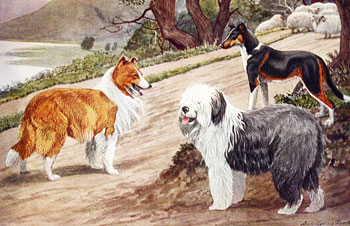Dog Breeds
Dog Tips
Training
Exercise
Medical
Interviews
Miscellaneous
About DB
Contact DB
Resources

Illustration by Louis Agassiz Fuertes
English Sheepdog
Rapidly gaining in popularity, the curious woolly sheep-dog has become thoroughly established in the United States; he has long been used as a practical helper in the great sheep-ranges of western Canada. He bears to resemblance whatever to the familiar collie type of sheep-dog, but looks rather like a great long-legged, round-headed, bounding terrier.
He has a formidable voice, very different indeed from the rather fox-like yap of the collie, and while he is some 24 to 27 inches at the shoulder and weighs 60 to 80 pounds one can not quite get away from the impression that he is, in fact, a huge terrior of some kind. The effect is heightened greatly by the long woolly hair on his head and face, which virtually hides the clever eyes, and makes a study of his actual head-form very difficult. The hair on back and hips is very long; when combed out they look very curious indeed.
In color they are usually blue gray and white; any strong tendency toward brown is not good. The white usually occupies most of the head and fore-quarters.
He is a dog of very striking appearance – one might almost say of un-dog like appearance. He is large, rather tall on the legs, tailless, and covered from head to foot with a long, loose hair, which tosses about freely when he runs or jumps, giving him the appearance of a huge animated floor-mop. But if you part the hair on his face you will find a pair of beautiful intelligent, friendly eyes. He is active, good-natured, and makes a fine companion.
Dogs of this breed were not always bobtailed; originally they were probably as well provided with tails as other dogs. Many of them were used for herding, and consequently exempt from taxation. It is said that the drovers amputated the tails of their working sheep-dogs to distinguish them from those which were not exempted.
It is believed by some authorities that this mutilation, continued through many generations, created in the breed a tendency to produce tailless and short-tailed offspring. Whatever the cause, it is certain that today many Old English sheep-dog puppies are born bob-tailed. When they are born with tails it is customary to dock them to within an inche or two of the root, and the operation is performed not more than four days after birth.
The docking accentuates the characteristic rounded quarters and increases the somewhat bear-like appearance of the animal.
Did you enjoy this article? Let us know what you think by commenting below. Don't forget to Friend us on facebook and subscribe to our twitter feed to stay updated! Thanks for reading, recommend us to your friends! |
